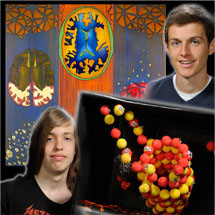 Young artists from Cambridgeshire schools brushed up on their neuroscience this summer to produce spectacular artwork. Their achievements were celebrated at an award ceremony at the LMB this week.
Young artists from Cambridgeshire schools brushed up on their neuroscience this summer to produce spectacular artwork. Their achievements were celebrated at an award ceremony at the LMB this week.
Imagining the Brain is a project that invites Cambridgeshire pupils with an interest in art and science to cut through the jargon usually associated with complex subjects like neuroscience and use art as a means of communication.
This year, the theme, The Art of Mortality, allowed artists to explore how pathogens can be so successful, looking particularly at why the Black Death was such a devastating epidemic. A different sort of mortality was addressed in the topic of neurodegeneration, in which some of the most recent research into devastating diseases like Parkinson’s and Alzheimer’s was movingly and expertly depicted by the artists.
Edward Parkhouse (The Leys) and Patrick Lyons (Parkside Federation Academies) won joint first prize. Edward produced a stunning triptych showing the structure of the brain seen through scanning technology and Patrick’s work was a sculpture showing the disruption of an essential component of nerve cells that occurs in Alzheimer’s disease. They both received a prize of £100.
Tristan Currie and Madeleine Lawson, both from Netherhall Sixth Form Centre, won second and third place respectively, with highly commended awards going to Chloe Austin and Adam Duncan from Parkside, Kirtee Kebla from Netherhall and Frances Thompson from Impington Village College.
Impington Village College was awarded the KPMG School Science Communication Award, in recognition of their participation in the project since its inception and the College’s commitment to engaging students with the forefront of scientific research. In recent years Impington has produced two artists in residence for the project whose work has been used internationally. The £500 award, made possible through the generosity of KPMG, was welcomed by the Head of Art, Graham McGregor. “We intend to buy new equipment for the art department with this money. It will make a real difference to the artwork that our students can do.”
The judges for this year’s exhibition were full of praise for the artists and the project:
Your science question for this year’s themed exhibition (as always) was contemporary, exciting and at the forefront of current research. The students were obviously inspired as their response was high and it was a delight to see such an array of imaginative and high calibre works delivered using a wide range of media. Given the diversity of interpretation, selecting winners is always a challenge, yet as an artist-engineer, it is one I relish. I see art and science not as separate entities but linked by their aims of creativity, curiosity, beauty and innovation. One of this competition’s strengths is to promote these ideals and cross discipline intentions to students who may feel bounded by curriculum choice. (Diana Scarborough, Artist and Engineer)
Imagining the Brain is a fantastic opportunity for young, aspiring artists to develop their own practice as well as bringing together the parallel disciplines of art and science. It affords young artists the chance to experience working to a brief, applying their arts practice to a new and different concept and, if they are selected, they can experience being an artist-in-residence. I was delighted to see the high quality and variety of media used by the young artists in the realisation of their final pieces. Imagining the Brain encapsulates the benefits of having such progressive institutions, such as the MRC-LMB, on our door-step in Cambridge. (Karen Thomas, Arts Development Manager, Swavesey and surrounding area)